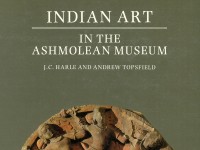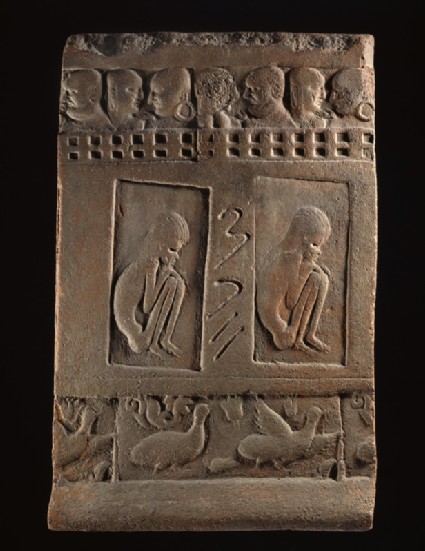Indian Art in the Ashmolean Museum
A catalogue of the Ashmolean’s collection of Indian art by J. C. Harle and Andrew Topsfield (published Oxford, 1987).

Publications online: 143 objects
- Reference URL
Actions
Terracotta tile with two ascetic figures
-
Literature notes
These large moulded tiles come from the courtyard surrounding the ruins of an apsidal-ended building at the Buddhist monastery of Harwan. Situated a few miles from Sringar, it was unfortunately obliterated by a landslide some years ago. The tiles formed the risers of a bench at one end of the courtyard where presumably the monks sat. Similarly moulded but generally smaller tiles, bearing an astonishing variety of motifs, lined the floor of the courtyard. The Museum possesses some portions of these, one of which shows a mounted bowman.
The style of the these and the other tiles, quite likely earlier than any other artefacts of the historical period from the Vale of Kashmir, is unique, combining Indian, Sassanian, possibly even Chinese motifs and some so far unknown elsewhere. The villainous faces of some of the figures above faintly recall Roman portrait sculptures. They are consequently particularly difficult to date. On the Indian time scale they would appear to belong to the 4th-5th centuries A.D. Each plaque bears numerals in the Kharoṣṭhi script [EA1985.5], probably indicating the position of each tile when they had been stamped on a large expanse of wet clay before being cut out, for firing, so that they could be re-assembled afterwards. An additional note of uncertainty is provided by the emaciating squatting figures in the two central panels, with their long hair. Buddhist practice did not encourage excessive fasting and even Buddhist monks shaved their heads; perhaps these are the spirits of the dead or ghosts (pretas), creatures of the burning-ground or charnel house which, set against the purity of the Buddhist monk or the Hindu ascetic desiring release from rebirth (mumukṣā), provide one of the constant themes of Indian religious art. -
Description
Large moulded tiles of this type formed the risers to a bench at one end of the courtyard of a Buddhist monastery at Harwan near Srinagar (now destroyed). Their iconography is enigmatic, with a row of conversing heads at top; central figures of long-haired ascetics (probably not Buddhist, but of some other sect such as the Ajivikas); and ducks and lotuses below. This tile is numbered 32 in kharoshthi script.
-
Details
- Associated place
-
Asia › India › north-west India › Jammu and Kashmir › Srinagar district › Harwan (Buddhist monastery) (place of creation)
- Date
-
2nd half of the 4th century - 1st half of the 5th century AD
Gupta Period (AD 320 - 600)
- Material and technique
- terracotta, moulded
- Dimensions
- 53.1 x 34.5 x 5.9 cm (height x width x depth)
- Material index
- Technique index
- Object type index
-
furniture/furnishings › furniture › seat › bench,architecture › tile,
- No. of items
- 1
- Credit line
- Purchased, 1980.
- Accession no.
- EA1980.65
-
Further reading
Harle, J. C., and Andrew Topsfield, Indian Art in the Ashmolean Museum (Oxford: Ashmolean Museum, 1987), no. 27 on p. 21, p. xiv, illus. p. 21
Harle, J. C., Gupta Sculpture: Indian sculpture of the Fourth to the Sixth Centuries A.D. (Oxford: Clarendon Press, 1974), illus. 57, Pl.144
Ahuja, Naman, ‘Early Indian Art at the Ashmolean Museum - Catalogue in progress’, 2016, no. 61.4
Location
Objects are sometimes moved to a different location. Our object location data is usually updated on a monthly basis. Contact the Jameel Study Centre if you are planning to visit the museum to see a particular object on display, or would like to arrange an appointment to see an object in our reserve collections.
Galleries
Publications online
-

Indian Art in the Ashmolean Museum
These large moulded tiles come from the courtyard surrounding the ruins of an apsidal-ended building at the Buddhist monastery of Harwan. Situated a few miles from Sringar, it was unfortunately obliterated by a landslide some years ago. The tiles formed the risers of a bench at one end of the courtyard where presumably the monks sat. Similarly moulded but generally smaller tiles, bearing an astonishing variety of motifs, lined the floor of the courtyard. The Museum possesses some portions of these, one of which shows a mounted bowman.
The style of the these and the other tiles, quite likely earlier than any other artefacts of the historical period from the Vale of Kashmir, is unique, combining Indian, Sassanian, possibly even Chinese motifs and some so far unknown elsewhere. The villainous faces of some of the figures above faintly recall Roman portrait sculptures. They are consequently particularly difficult to date. On the Indian time scale they would appear to belong to the 4th-5th centuries A.D. Each plaque bears numerals in the Kharoṣṭhi script [EA1985.5], probably indicating the position of each tile when they had been stamped on a large expanse of wet clay before being cut out, for firing, so that they could be re-assembled afterwards. An additional note of uncertainty is provided by the emaciating squatting figures in the two central panels, with their long hair. Buddhist practice did not encourage excessive fasting and even Buddhist monks shaved their heads; perhaps these are the spirits of the dead or ghosts (pretas), creatures of the burning-ground or charnel house which, set against the purity of the Buddhist monk or the Hindu ascetic desiring release from rebirth (mumukṣā), provide one of the constant themes of Indian religious art.
Notice
Object information may not accurately reflect the actual contents of the original publication, since our online objects contain current information held in our collections database. Click on 'buy this publication' to purchase printed versions of our online publications, where available, or contact the Jameel Study Centre to arrange access to books on our collections that are now out of print.
© 2013 University of Oxford - Ashmolean Museum



